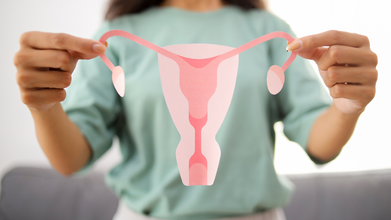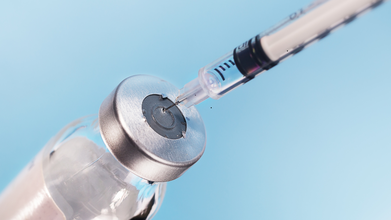- Health Conditions A-Z
- Health & Wellness
- Nutrition
- Fitness
- Health News
- Ayurveda
- Videos
- Medicine A-Z
- Parenting
- Web Stories
High Blood Pressure May Have A New Answer For Better Results, Renal Denervation

(Credit-Canva)
High blood pressure has been one of the biggest issues for Americans, not only is it difficult to control but also only 23% of people with high blood pressure actually achieve their treatment goals according to the American Heart Association. Usually treating high blood pressure means changing your lifestyle and making sure you eat your medication. It is a lifelong commitment you need to make as neglecting your high blood pressure will put a strain on your heart, eventually causing you cardiovascular issues as well.
Doctors often recommend things like losing weight, getting regular exercise, eating a healthy diet with lots of fruits and vegetables, cutting back on salt and alcohol, and managing stress. When that does not work, you have take the support of medication. but there happen to be other people who are resistant to medication as well, so are they left with no options?
In 2023, the US government approved a new treatment for high blood pressure called renal denervation. It's a procedure where doctors use a thin tube (catheter) to calm down nerves near the kidneys that contribute to high blood pressure.
Why Should Renal Denervation Be Considered?
This treatment is for people whose blood pressure is still too high even after trying healthy lifestyle changes and medications. This approval came after several well-designed studies compared the real procedure to a fake one (called a sham procedure), where patients went through the motions of the procedure but didn't actually have the nerves treated. Most of these studies showed that the real procedure did lower blood pressure a bit, in people with different levels of high blood pressure, from mild to very hard-to-treat. It's important to know that it doesn't work the same for everyone, and doctors are still trying to figure out who will benefit the most. So far, it seems pretty safe, and ongoing studies are looking at how well it works and how safe it is over a longer period. To make sure people get the best care, it's important for teams of doctors, including blood pressure specialists and doctors trained to do the procedure, to work together. This will help them decide who is a good candidate and carefully weigh the risks and benefits. Talking openly with patients and considering what they want is also key, so they can make the best choices for themselves.How This Is Used For High Blood Pressure Treatment?
Some people have high blood pressure that doesn't get better even with medicine. This is called resistant hypertension. A treatment option is renal denervation (RDN). It's a simple procedure where doctors use heat which is radiofrequency ablation to quiet down the nerves in the arteries of the kidneys. This helps lower blood pressure. Renal denervation (RDN) is a relatively new procedure, so its long-term effects aren't fully known yet. While it has been shown to effectively lower blood pressure, there are some potential risks. Some patients might experience a slow heart rate during the procedure, which can be treated with medication. The heat used in the procedure could cause narrowing of the renal arteries in some cases. This can be fixed with a stent which is a tiny tube inserted to widen the artery. Also the imaging used during the procedure can cause bruising at the puncture site which is usually in the thigh. There's also a small chance of a pseudoaneurysm, a collection of blood outside the artery or a tear in the renal artery.
THIS Common Hormone Condition Is The Most Misdiagnosed In Women

Credits: Canva
Scrolling through social media, many women encounter stories of celebrities describing years of unexplained symptoms before receiving a diagnosis of polycystic ovary syndrome (PCOS). Model and actress Lori Harvey recently shared her experience with weight fluctuations, acne, facial hair growth, and painful irregular periods, highlighting a common struggle among women of reproductive age. Stories like hers resonate with women like Alexis King, who found validation in hearing someone else’s journey, as reported in Washington Post.
PCOS is a hormone disorder affecting roughly one in ten women worldwide, including about six million Americans. It is linked to both reproductive and metabolic dysfunction, increasing the risk of fertility problems as well as chronic conditions such as high blood pressure, diabetes, obesity, and cardiovascular disease. Despite its prevalence, PCOS remains underfunded and under-recognized, leaving many women to navigate the condition largely on their own.
A “Silent” Diagnosis
For many, PCOS is identified only after years of unexplained symptoms. Patients often encounter healthcare providers who focus on cosmetic solutions rather than addressing the underlying hormonal imbalance. Researchers note that PCOS is considered an “orphan disorder” in women’s health, receiving significantly less funding than conditions with comparable prevalence and severity. From 2016 to 2022, average annual funding for PCOS was around $32 million, compared with $262 million for rheumatoid arthritis and $66 million for tuberculosis, according to recent studies reported in Washington Post.
Experts stress the need for comprehensive management rather than relying on individual supplements, though some, such as inositol, have shown promise in improving metabolic and reproductive outcomes. There is no cure or FDA-approved treatment specifically for PCOS, though existing interventions can alleviate symptoms and reduce long-term health risks, according to Richard Legro, chair of obstetrics and gynecology at Penn State Health Milton S. Hershey Medical Center, as reported in Washington Post.
Challenges in Diagnosis
A full PCOS diagnosis requires meeting at least two of three criteria: irregular periods, elevated male hormones, or ovaries with fluid-filled sacs visible on ultrasound. Yet many patients never undergo complete hormone testing or imaging, leaving the disorder undiagnosed for years. Clinicians often lack training to treat PCOS effectively, as it spans multiple specialties, from reproductive endocrinology to general gynecology. Multidisciplinary clinics exist but are limited in number, forcing patients to seek care from providers unfamiliar with the full scope of the disorder, as reported in Washington Post.
Delayed diagnosis can have serious consequences. Women with PCOS face increased risks of infertility, pregnancy complications, and chronic conditions. Endometrial cancer risk is higher due to irregular shedding of the uterine lining, and Black women experience disproportionately higher rates of adverse outcomes due to later diagnosis and barriers to care.
Research and Emerging Treatments
In the absence of robust funding, clinicians have relied on medications such as metformin, which improves insulin sensitivity, to manage PCOS symptoms. Research is also exploring the use of weight-loss drugs, such as semaglutide, to regulate hormone levels, restore periods, and reduce metabolic risks. Early trials show promise, with participants reporting restored menstrual cycles, improved hormone balance, and weight loss, as reported in Washington Post.
Despite these advances, insurance coverage remains a challenge. Patients often must pay out of pocket for medications that are not yet FDA-approved specifically for PCOS. Researchers like Melanie Cree, a pediatric endocrinologist, are pushing for standardized testing and more clinical trials, but funding delays and reduced philanthropic support continue to slow progress.
As awareness grows, advocates and researchers aim to prioritize PCOS as a significant public health concern, emphasizing early detection, comprehensive treatment, and equitable access to care. For millions of women, improved understanding and treatment of PCOS could transform lives, reducing both immediate discomfort and long-term health risks, as reported in Washington Post.
NHS Approves Injection That Could Stop HIV

Credits: Canva
For the first time, patients in England and Wales will be able to access a long-acting injection to prevent HIV through the NHS, bringing the policy in line with Scotland. The new jab, administered every two months, provides an alternative to daily oral pills, offering convenience and discretion for those who find tablets challenging to take.
Experts hope the introduction of cabotegravir (CAB-LA) injections will help the UK meet its goal of eliminating new HIV cases by 2030. Meanwhile, early results from another injection, lenacapavir, suggest that annual HIV prevention injections could become a possibility in the future.
A “Game-Changing” Option
Wes Streeting, the Secretary of State for Health and Social Care, described the new injection as “game-changing” and told the BBC: “For vulnerable people who are unable to take other methods of HIV prevention, this represents hope”.
HIV prevention therapy, known as PrEP (pre-exposure prophylaxis), is used by HIV-negative individuals to reduce the risk of infection. While daily oral PrEP has been effective for years, some people find it difficult to adhere to. Challenges include lack of privacy, homelessness, domestic violence, or the fear of others discovering their medication.
A long-acting injection that lasts for months addresses these issues, offering both practicality and discretion. Cabotegravir, produced by ViiV Healthcare, is intended to be used alongside safer sex practices, such as condom use. NHS England has secured a confidential discount from the manufacturer, whose list price is around £7,000 per patient per year, as reported by the BBC.
Who Will Be Eligible?
The injection will be offered to adults and adolescents at high risk of sexually acquired HIV who are eligible for PrEP but may struggle with daily tablets. Around 1,000 people are expected to be offered the injection initially, with others continuing or starting oral PrEP. Patients can access it through NHS-operated sexual health clinics “in the coming months,” according to the National Institute for Health and Care Excellence (NICE).
Dom Baldwin, who currently takes PrEP pills, told the BBC he is “over the moon” about the injections: “When you look at where we are now compared to the epidemic in the 80s… HIV is no longer a death sentence”.
Calls for Rapid and Equitable Rollout
Charities have emphasized the need for a fast rollout, as some patients face long waits for appointments. Richard Angell, of the Terrence Higgins Trust, said to the BBC that the therapy should be offered in more settings, not just sexual health clinics: “It’s highly effective and acceptable for patients, and a vital tool for tackling inequalities, with the potential to reach those who are not currently accessing other HIV prevention”.
Official figures show that PrEP access in England is increasing, but gaps remain. In 2024, 146,098 HIV-negative people attending sexual health services were at substantial risk of HIV, with about 76% starting or continuing PrEP, a 7.7% rise from 2023. However, uptake varies by group, with lower rates among black African heterosexual men and women compared to men who have sex with men.
Dr Michael Brady, NHS England’s National Advisor for LGBT+ Health, said to the BBC: “This long-acting injection is a significant addition to our HIV prevention strategies, giving us a powerful new option for people at risk of HIV who cannot have oral PrEP tablets”.
Non-Communicable Diseases Account for Two-Thirds of Global Deaths, Says Report

Credits: Canva
In a recent study published in The Lancet, by the Global Burden of Disease Study, 2023 reveals that non-communicable diseases (NCDs) like heart disease, stroke, and diabetes now account for nearly two-thirds of global deaths, surpassing infectious diseases, according to an analysis of over 33 years.
The study covered 375 diseases and injuries, including 88 risk factors and healthy life expectancy across 204 countries and territories. It included 660 subnational locations, from 1990 to 2023.
The report also highlighted the sharp rise in mental health disorders with anxiety disorders, which were increased by 63%. The report also noted an increase in depressive disorders by 26%.
Environmental Factors That Impact Health
Furthermore, it added that environmental risks such as extreme heats and air pollution also bears an impact on health. There have been deaths due to climate-sensitive exposures rising by 6% annually between 2013 and 2023.
In fact, recently, a health conference of the Indian Rheumatology Association revealed that pollution also triggers rheumatoid arthritis. Heat waves also pose serious health risks, from heat cramps and exhaustion to the life-threatening heatstroke, by overwhelming the body's ability to cool itself.
An Increase In Life Expectancy Rate
As per the study, the global life expectancy rates have rebounded post COVID-19 pandemic. It has now reached 76.3 for women and 71.5 years for men in 2023. Earlier, in the pandemic, the age for women went down to 74.7 years, while for men, it was at 69.3 years, in 2021. Since 1950, the global life expectancy has increased by roughly 20 years.
In 2023, the total deaths globally reached 60.1 million, which included 4.67 million deaths of children under five. The population growth and aging however has driven a 35.2 per cent increase in global deaths since 1950, under-five mortality has steadily declined in this period.
The report also highlighted the difference in the health outcomes. The global life expectancy has improved, however, the geographic inequities still persisted. The mean age at death rose from 46.4 years in 1990 to 62.9 years in 2023.
Who Lived Longer, Where?
High-income countries reported the longest lifespans, women lived up to 80.5 years on average, while men reached 74.4 years. In stark contrast, sub-Saharan Africa recorded the lowest life expectancy, with women living an average of 37.1 years and men 34.8 years.
The report highlights that nearly half of all global deaths and disabilities could be prevented by tackling key risk factors such as high blood sugar, obesity, and social determinants like sexual abuse and intimate partner violence.
India recorded 9.85 million deaths in 2023, ranking second after China’s 10.7 million. The average life expectancy in India stood at 73 years for women and 70.2 years for men.
Encouragingly, India has made notable strides in reducing child mortality. The under-five mortality rate has dropped to 32.1 deaths per 1,000 live births. However, due to the country’s large population, the total number of deaths among children under five remained high, at around 6,92,000.
© 2024 Bennett, Coleman & Company Limited

